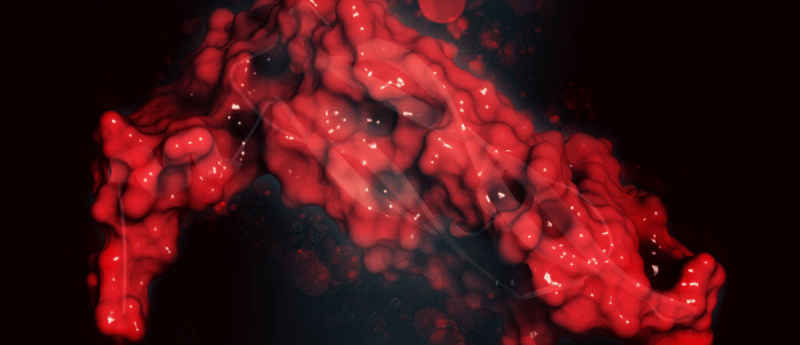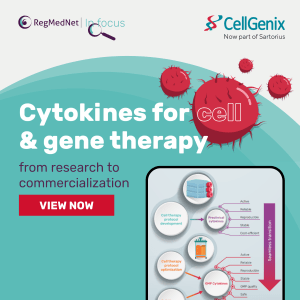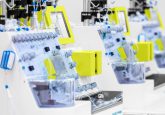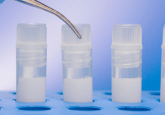Raw materials considerations for a seamless transition into GMP manufacturing: an interview with Bernd Leistler

In this interview, we spoke with Bernd Leistler about the significance of raw materials in the development and manufacturing of cell and gene therapies and how product requirements change when transitioning from research to preclinical development and beyond to the clinical and commercial manufacturing phases.
This interview is part of the RegMedNet In Focus on raw materials. Discover expert opinions on this topic by visiting our feature homepage.
What is the significance of raw materials in the successful commercialization of cell and gene therapies?
Raw materials play an important part in the successful commercialization of cell and gene therapies, as they directly impact safety, efficacy, and quality. The challenge lies in the fact that biological raw materials are inherently variable, while batch-to-batch consistency is essential for successful and long-term commercialization of therapies.
Variations in the quality of raw materials may lead to unwanted effects, like lower expansion rates or an altered surface marker profile of the cells. It is, therefore, crucial to establish a production process for the raw materials, in which all aspects are well designed and controlled, including the source and quality of production materials, to ensure the desired output. Raw materials of consistent and reliable high quality, sourced from qualified suppliers, are therefore an essential prerequisite to the successful manufacture of cell and gene therapies.
The advantage of using consistent and reliable high-quality raw materials is that cell therapy developers can release their therapies to patients with confidence while preventing manufacturing issues.
What’s your advice on how to qualify raw materials and assess their quality risks?
Cell-based therapies and viral vectors have a lot of inherent variability themselves, so it’s critical to minimize raw materials variability to not contribute further.
The most important raw material characteristics to monitor greatly depend on its intended use and function in the manufacturing process. A risk-based approach should be used as early as possible to define the most important characteristics for each raw material.
To do so, it is important to understand the Critical Quality Attributes (CQAs) of the cell therapy product in order to evaluate the potential effect of your raw materials on the quality of your therapeutic product.
The quality of the cell therapy product could be influenced by raw material properties, that are not tested by quality control (QC) and are, therefore, not part of the certificate of analysis (e.g., glycosylation or (de)amidation, which can influence receptor binding). In this case, the supplier should be asked for supportive analytical or validation data. To analyze variabilities and the impact on your cell therapy product, it is important to trend your data with raw materials and build a robust data set.
Raw materials should be fit for purpose. Therefore – beyond properties like consistency, safety, identity and purity – functionality plays a great role in specifications and should be monitored.
Release tests performed by the supplier should be good indicators of these parameters. The raw material manufacturer’s test for functionality may differ from the specific conditions at the end user’s production process, but they should be closely monitored and may serve as indicators for the consistency and quality of a given raw material.
The recently published ISO 20399:2022 sets out a summary table of responsibilities requirements of both suppliers and users of raw materials to improve consistency and quality, which is a good starting point when embarking on or reviewing service agreements.
We believe there are six critical success factors that contribute to a robust raw materials risk assessment process:
- Ensure quality upfront (e.g., by auditing the supplier and by looking at the supplier’s Certificate of Authenticity and supportive data).
- Understand and meet expectations from regulators.
- Define how raw materials are used in the process.
- Identify reliable raw material suppliers with consistent quality and a secure supply chain.
- Evaluate lot-to-lot consistency or ask the supplier for relevant consistency data.
- Define risk for each material and characterize the most critical ones.
Why use preclinical grade raw materials for preclinical research instead of RUO reagents?
In an ideal world, RUO materials should be used only in the discovery phase.
Our preclinical-grade cytokines are manufactured under the same conditions as our GMP cytokines, using identical production steps and expression systems. This ensures equal product quality and performance. The documentation for GMP is different, but the product is comparable.
Our preclinical grade raw materials were developed to be a GMP product to not cause alterations later down the line. This ensures that preclinical data is valid for later clinical phases, enabling a seamless transition.
Starting up-front and early with the materials you intend to use in GMP manufacturing saves significant time in the long-term. When making that transition to GMP, it’s important to demonstrate that your product is meeting its defined specifications, and for that, you need data. Preclinical grade raw materials allow you to begin collecting reliable data as early as possible and more economically, which will in turn inform your process.
RUO materials are, in most cases, manufactured differently to GMP-grade materials ̶ by ill- defined, -controlled and -validated processes ̶ and they are also not tested as rigorously as a GMP-grade product, resulting in a need to retest many parameters yourself.
When should developers start to consider switching to GMP-grade raw materials?
To enable a seamless transition, we recommend identifying the appropriate GMP-grade raw materials and reliable suppliers as early as possible, at least prior to clinical development.
Changing raw materials at a later stage in clinical development to meet the increased regulatory requirements often creates significant additional costs and loss of precious time because clinical comparability studies must be performed. This can be prevented by using preclinical grade raw materials that allow a seamless transition.
For critical and complex raw materials, such as cell culture media, we advise starting with GMP from the beginning. This will prevent the need to perform complex process optimization steps when switching raw materials.
How can you offset the additional costs of using GMP-grade materials earlier than required?
Using high-grade raw materials in preclinical development reduces or completely negates the need for process optimization steps, new raw material risk assessment, or clinical comparability studies needed when switching to the clinical phase.
This early investment therefore saves much time and cost in the long term and provides a level of assurance.
Early adoption of GMP-grade raw materials offers a high safety and consistency level and, therefore, prevents manufacturing issues, like raw material contaminations, which can have a major effect on your manufacturing process.
How can raw material suppliers support developers who are going through the regulatory process?
Getting a clear understanding of regulatory requirements around the quality of raw materials can be challenging. There is currently no global harmonization and existing guidelines can be interpreted in different ways.
Our highly experienced regulatory affairs team provides expert regulatory support. Part of their work is to prepare a set of specific documents such as product-specific data sheets, technotes explaining our Animal-Derived Component Free policy, providing information on our stability programs or on-demand customized documentation for regional authorities. These documents have proven invaluable to provide quality information on our products.
We also maintain Drug Master Files (DMF): seventeen (soon to be eighteen). DMFs are filed at the FDA Center for Biologics Evaluation and Research (CBER), and one has been submitted to the Japanese health authority (PMDA). A Drug Master File (DMF) is a regulatory instrument that provides confidential detailed information about the product safety, manufacturing conditions and analytical aspects. Through this pathway, the raw material manufacturer is able to protect its intellectual property by allowing the authority to review the information in support of a third party’s regulatory submission (e.g., IND or BLA). Maintaining a high level of information and keeping it up to date is crucial for the support we provide to our customers and for our communication with the authorities.
We believe that it is crucial to keep up to date with evolving regulations. By actively participating in many regulatory initiatives and discussions we keep abreast of developments and help improve regulatory guidance. We therefore maintain an active regulatory surveillance of different domains of interest. In addition, we have been actively involved in different professional groups (for instance Alliance for Regenerative Medicine) or committees (e.g., ISO committees).
What’s the best way to troubleshoot your raw materials supply chain to keep pace with rapidly increasing demand?
Having agility in your supply chain to keep up with changes in demand is crucial for delivering treatments to patients on time.
To achieve this, it is important to establish good communication with your partners and maintain the relationship beyond supply agreements, which will create channels to openly share information. For example, forecasting – let them know where you’re heading, keeping track of supply agreements and commitments. Alternative suppliers should also be identified during the due diligence process to ensure a level of risk mitigation and security of supply.
Another consideration is the geographical regions you may need to expand into, as there may be raw materials that are available in Europe that might not be available in Asia, for instance.
Finally, assessing your supplier’s ability to scale with you should be part of the initial due diligence. Criteria to assess this compatibility could be inquiring about the capacity of their manufacturing facility and any plans for future facility expansions.
What are your top three considerations to ensure a seamless transition into GMP manufacturing?
- Start your early-stage process development with preclinical or GMP-grade raw materials allowing, for a seamless transition from preclinical to clinical development and beyond.
- Set up a robust raw materials risk assessment process, including supply chain risks. Share your forecasted needs with your suppliers and make sure they can cope with the increasing demand.
- Have a robust data set to check comparability if you transition to GMP raw materials.
Meet the interviewee
Bernd Leistler, Vice President Production, Sartorius CellGenix
 As Vice President of Production at Sartorius CellGenix (Freiburg im Breisgau, Germany), Bernd is responsible for the production and process development of the CellGenix® preclinical and GMP cytokines. Bernd has a long track record as a protein specialist. Following his degree in chemistry, he started his scientific career at the Basel Biocenter (Basel, Switzerland) for his dissertation on the structure, function, folding and assembly of oligomeric proteins. He continued these studies as a postgraduate researcher in Cambridge, UK.
As Vice President of Production at Sartorius CellGenix (Freiburg im Breisgau, Germany), Bernd is responsible for the production and process development of the CellGenix® preclinical and GMP cytokines. Bernd has a long track record as a protein specialist. Following his degree in chemistry, he started his scientific career at the Basel Biocenter (Basel, Switzerland) for his dissertation on the structure, function, folding and assembly of oligomeric proteins. He continued these studies as a postgraduate researcher in Cambridge, UK.
His professional career started in 1993 at a leading manufacturer of diagnostic autoantibody immunoassays in Freiburg im Breisgau, Germany, which later became part of Pharmacia Diagnostics (Uppsala, Sweden). There he managed the Biotechnology Department and developed it as a corporate service unit for recombinant and conventional human autoantigens and allergens.
Bernd joined Sartorius CellGenix in 2003. At Sartorius CellGenix, he first took responsibility for the production of various protein vaccines. Having acted as a Qualified Person under the supervision of the competent authorities, he now uses his knowledge and experience to ensure that cytokine production is in line with the relevant GMP guidelines.
Disclaimer
The opinions expressed in this interview are those of the interviewee and do not necessarily reflect the views of RegMedNet or Future Science Group.
In association with







